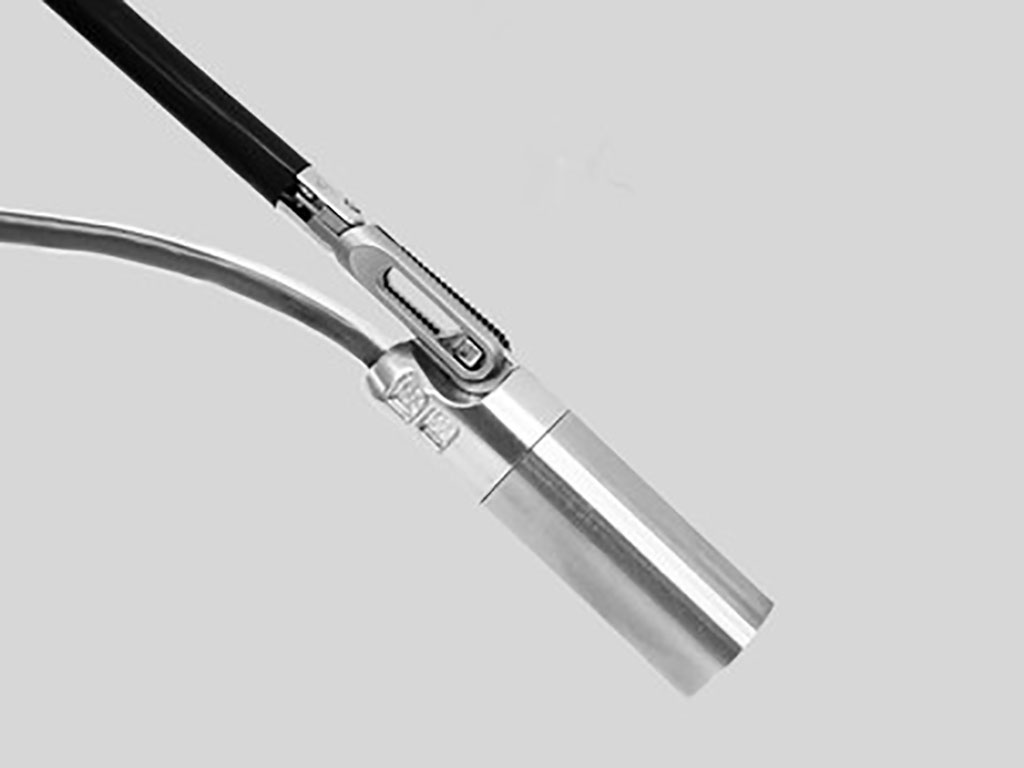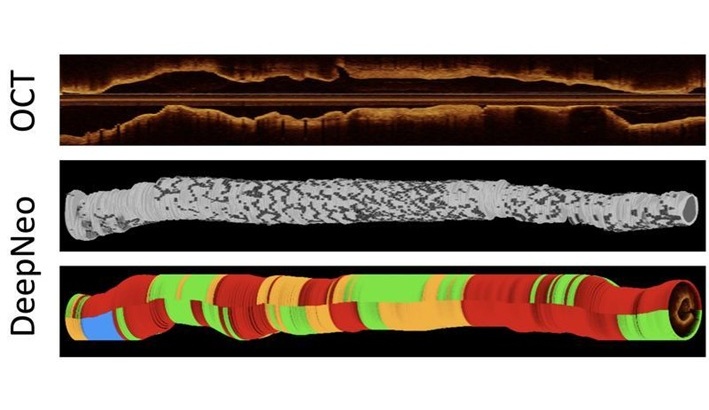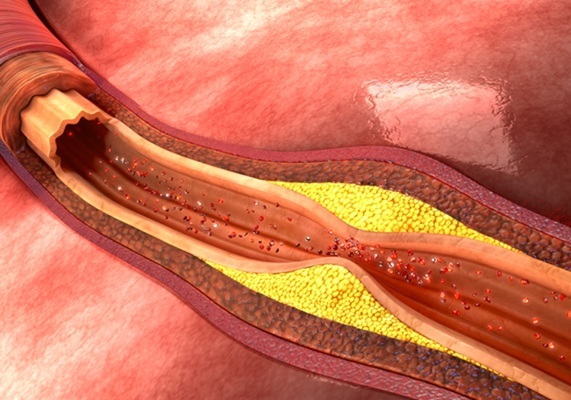Robotic Gamma Probe Detects Cancer Intra-Operatively 
|
By HospiMedica International staff writers Posted on 27 Jan 2021 |

Image: The Sensei Robotic Gamma Probe (Photo courtesy of Lightpoint Medical)
A novel intra-operative probe detects sentinel lymph node (SLN) and other cancer metastases through the lymphatic system.
The Lightpoint Medical (Chesham, United Kingdom) Sensei is a tethered gamma probe designed to be used as a guide during laparoscopic biopsy procedures. The probe locates single-photon emission computed tomography (SPECT) radioligands, such as 99mTc-nanocolloid for SNL metastasis detection, or for targeted cancer metastasis antigens, such as 99mTc-PSMA (prostate specific membrane antigen) during prostate cancer surgery. The single-use, disposable probe measures just over 40mm and is attached to a three meter long lightweight cable, supporting both intra-cavity manual and robotic laparoscopic procedures.
When used with articulating graspers, the probe can provide up to six degrees of freedom, allowing for complete intra-cavity maneuverability and dexterity. The system provides clear audible notifications and is also equipped with a graphic display. It can also be integrated with the display of any surgical robotic platform. And as it is disposable, there is no need for a sterile sheath or reprocessing, eliminating the risk of cross-contamination. At the end of the procedure, the probe can be easily extracted through a standard 12mm entry port for disposal.
“Lightpoint is developing the most advanced intra-operative cancer detection technologies to meet surgeons' needs for miniaturized cancer detection tools,” said David Tuch, CEO of Lightpoint Medical. “Currently, surgeons have no way to precisely detect cancer intra-operatively. As a result, millions of patients suffer every year as cancer is frequently left behind or healthy, functional tissue is needlessly removed.”
Lymph nodes, located throughout the body, serve as biologic filters that contain immune cells to fight infection and clean the blood. When cancer cells break away from a tumor, the cells can travel through the lymph system, and SNLs help determine cancer spread. But human SNLs are only half a centimeter in size, and are difficult to discern among the surrounding tissue during surgery. Furthermore, even when surgeons are able to map the location of the nodes, there is no current technique that indicates whether or not the lymph nodes contain cancer, requiring their removal.
Related Links:
Lightpoint Medical
The Lightpoint Medical (Chesham, United Kingdom) Sensei is a tethered gamma probe designed to be used as a guide during laparoscopic biopsy procedures. The probe locates single-photon emission computed tomography (SPECT) radioligands, such as 99mTc-nanocolloid for SNL metastasis detection, or for targeted cancer metastasis antigens, such as 99mTc-PSMA (prostate specific membrane antigen) during prostate cancer surgery. The single-use, disposable probe measures just over 40mm and is attached to a three meter long lightweight cable, supporting both intra-cavity manual and robotic laparoscopic procedures.
When used with articulating graspers, the probe can provide up to six degrees of freedom, allowing for complete intra-cavity maneuverability and dexterity. The system provides clear audible notifications and is also equipped with a graphic display. It can also be integrated with the display of any surgical robotic platform. And as it is disposable, there is no need for a sterile sheath or reprocessing, eliminating the risk of cross-contamination. At the end of the procedure, the probe can be easily extracted through a standard 12mm entry port for disposal.
“Lightpoint is developing the most advanced intra-operative cancer detection technologies to meet surgeons' needs for miniaturized cancer detection tools,” said David Tuch, CEO of Lightpoint Medical. “Currently, surgeons have no way to precisely detect cancer intra-operatively. As a result, millions of patients suffer every year as cancer is frequently left behind or healthy, functional tissue is needlessly removed.”
Lymph nodes, located throughout the body, serve as biologic filters that contain immune cells to fight infection and clean the blood. When cancer cells break away from a tumor, the cells can travel through the lymph system, and SNLs help determine cancer spread. But human SNLs are only half a centimeter in size, and are difficult to discern among the surrounding tissue during surgery. Furthermore, even when surgeons are able to map the location of the nodes, there is no current technique that indicates whether or not the lymph nodes contain cancer, requiring their removal.
Related Links:
Lightpoint Medical
Latest Surgical Techniques News
- DNA Origami Improves Imaging of Dense Pancreatic Tissue for Cancer Detection and Treatment
- Pioneering Sutureless Coronary Bypass Technology to Eliminate Open-Chest Procedures
- Intravascular Imaging for Guiding Stent Implantation Ensures Safer Stenting Procedures
- World's First AI Surgical Guidance Platform Allows Surgeons to Measure Success in Real-Time
- AI-Generated Synthetic Scarred Hearts Aid Atrial Fibrillation Treatment
- New Class of Bioadhesives to Connect Human Tissues to Long-Term Medical Implants
- New Transcatheter Valve Found Safe and Effective for Treating Aortic Regurgitation
- Minimally Invasive Valve Repair Reduces Hospitalizations in Severe Tricuspid Regurgitation Patients
- Tiny Robotic Tools Powered by Magnetic Fields to Enable Minimally Invasive Brain Surgery
- Magnetic Tweezers Make Robotic Surgery Safer and More Precise
- AI-Powered Surgical Planning Tool Improves Pre-Op Planning
- Novel Sensing System Restores Missing Sense of Touch in Minimally Invasive Surgery
- Headset-Based AR Navigation System Improves EVD Placement
- Higher Electrode Density Improves Epilepsy Surgery by Pinpointing Where Seizures Begin
- Open-Source Tool Optimizes Placement of Visual Brain Implants
- Easy-To-Apply Gel Could Prevent Formation of Post-Surgical Abdominal Adhesions
Channels
Critical Care
view channel
AI Model Analyzes Patient Data to Diagnose Multiple Sclerosis With 90% Accuracy
Multiple sclerosis (MS) is a chronic inflammatory condition affecting the central nervous system. Most patients initially experience the relapsing-remitting form (RRMS), characterized by periods of symptom... Read more
Magnetically Navigable Microparticles Enable Targeted Drug Delivery
Abdominal aortic aneurysms (AAA) can be life-threatening if not treated and result in nearly 10,000 deaths annually. Researchers working to improve treatments for AAA could now make it possible for doctors... Read more
AI-Powered Algorithm Automates Analysis of Coronary Stents After Implantation
Every year, over three million people globally receive stents to open blocked blood vessels caused by heart disease. However, monitoring the healing process after stent implantation remains a significant challenge.... Read morePatient Care
view channel
Portable Biosensor Platform to Reduce Hospital-Acquired Infections
Approximately 4 million patients in the European Union acquire healthcare-associated infections (HAIs) or nosocomial infections each year, with around 37,000 deaths directly resulting from these infections,... Read moreFirst-Of-Its-Kind Portable Germicidal Light Technology Disinfects High-Touch Clinical Surfaces in Seconds
Reducing healthcare-acquired infections (HAIs) remains a pressing issue within global healthcare systems. In the United States alone, 1.7 million patients contract HAIs annually, leading to approximately... Read more
Surgical Capacity Optimization Solution Helps Hospitals Boost OR Utilization
An innovative solution has the capability to transform surgical capacity utilization by targeting the root cause of surgical block time inefficiencies. Fujitsu Limited’s (Tokyo, Japan) Surgical Capacity... Read more
Game-Changing Innovation in Surgical Instrument Sterilization Significantly Improves OR Throughput
A groundbreaking innovation enables hospitals to significantly improve instrument processing time and throughput in operating rooms (ORs) and sterile processing departments. Turbett Surgical, Inc.... Read moreHealth IT
view channel
Printable Molecule-Selective Nanoparticles Enable Mass Production of Wearable Biosensors
The future of medicine is likely to focus on the personalization of healthcare—understanding exactly what an individual requires and delivering the appropriate combination of nutrients, metabolites, and... Read more
Smartwatches Could Detect Congestive Heart Failure
Diagnosing congestive heart failure (CHF) typically requires expensive and time-consuming imaging techniques like echocardiography, also known as cardiac ultrasound. Previously, detecting CHF by analyzing... Read moreBusiness
view channel
Expanded Collaboration to Transform OR Technology Through AI and Automation
The expansion of an existing collaboration between three leading companies aims to develop artificial intelligence (AI)-driven solutions for smart operating rooms with sophisticated monitoring and automation.... Read more
















